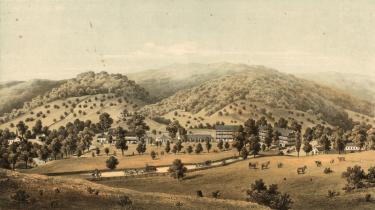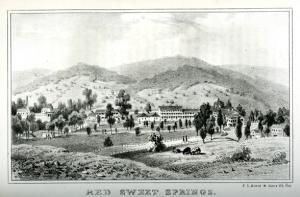Red Sweet Springs (Sweet Chalybeate Springs)
Alleghany County, Virginia
The effects experienced after coming out of these baths, provided the patient has not indulged himself in them too long, are as remarkable as they are agreeable … There is an elasticity and buoyancy of body and spirit that makes one feel like leaping walls or clearing ditches at a single bound. John J. Moorman

Edward Beyer’s print of the Red Sweet Springs published in 1857. {1}
William Burke on the Red Sweet Springs.
Only a mile from the Sweet Springs, the Red Sweet Springs in Alleghany County, Virginia, according to Dr. Burke’s book, The Mineral Springs of Western Virginia, had a beautiful situation “overlooking one of the most fertile and best cultivated farms in Virginia” and was owned by Richard Sampson and his son John. Dr. Burke had spent most of a summer at this establishment, also known as the Red Springs and the Sweet Chalybeate Springs, and testified to the “excellence of the fare, the comfort of the chambers, and the polite attention” of John Sampson and his manager. He was pleased with the design in terms of the convenience of the frame building that accommodated 60-70 people and boasted of a ball room, dining and bar-room, and two double-story galleries extending the length of the building. However, he was dismayed at the consequences of its location, “being thrown across the valley, as in the case of the Sweet Springs, it is destructive of the natural beauty of the locality.” Dr. Burke quoted a letter from John Sampson that described his new plans for improvements to the property as well as an assessment of the springs. Sampson noted that the various springs and pools ranged in temperature from 74 to 80 degrees and had a combined discharge of about 600 gallons a minute.
Burke’s Recommendations for Using the Waters at Red Sweet Springs.
One of the two bathing reservoirs was an octagon about 20 feet in diameter and boasted of “the finest spout imaginable,” a spout being a strong stream of water that could be directed to the particular part of the body most in need of soothing. Dr. Burke wrote that he did not stay in the bath longer than five minutes and gave a detailed description of the process undertaken upon leaving the water. He dried his head and neck while “a servant was engaged in rubbing the body with all his might.” After two minutes he wrote that a person felt “as if he could jump over the moon.”
Dr. Burke advised the Sampsons to “have two rubbers instead of one—a man and a small boy for the gentlemen; and a maid and little girl for ladies. After getting out of the bath, the person should be made to stand on a platform two feet square and about six inches elevated from the floor. In this should be some grooves to carry off the moisture from the feet, the junior rubber should then kneel down and with a coarse towel dry perfectly the legs and feet, while the bather and aid are employed on the head and trunk. With one rubber, the feet are apt to be left too long wet.” {Burke, 115-6}
Dr. Burke wrote that the bath was chalybeate or iron-containing and therefore a powerful agent in cases that benefit from a tonic treatment. He felt that 95% of the bathers would think the Red-Sweet Springs were more powerful as a tonic applied to the skin than the Sweet Springs. In terms of drinking water, he wrote, “its tonic property is acknowledged, and where such an agent is desirable it is not surpassed on the habitable globe.”
Seven pages are devoted to the skin, “that beautiful organ which, above all others, distinguishes man from the inferior animal creation, and which in lovely woman frequently attains such exquisite perfection as to place her second only to the angels.” Dr. Burke explained the custom of spending the first part of a season in sulphurous waters and then the later part of the season at the Hot, Warm and Sweet Springs as the sulphurous waters would be most effective on chronic diseases of the skin while the thermal waters would only relieve slight affections of the skin.
Documents from the Small Special Collections Library, University of Virginia:
- Letter from James D. Wood to Moses D. Hoge, September 8, 1843: Wood refers to his time at Alum Springs, Hot Springs and Red Springs. He is pleased with the improvement in his health.
- Letter from J. L. Cabell to Franklin Minor, 1860: Professor Cabell from the University of Virginia “cannot help thinking that making the worst of the Red Sweet she [Mrs. Minor] jumps out of the frying pan into the fire in selecting the Hot Springs.”
- Letter from B. Chapman to Mr. Eakle, 1896: The Albert and Shirley Small Special Collections Library of the University of Virginia has a manuscript collection of approximately 4,500 items pertaining to the Sweet Chalybeate Springs from 1892 to 1916. It contains business letters, daybooks, check stubs, an inventory of merchandise, and various receipts and brochures. This is one of many letters to Mr. B. F. Eakle, Jr., the manager at the springs.
Additional Information:
- National Register of Historic Places Nomination Form: This detailed form for the Red Sweet Springs is dated October 1973. It includes the history and significance of the springs, descriptions of remaining buildings, one map, and a bibliography.
- National Register of Historic Places: The National Register has a brief summary of places in Alleghany County, Virginia.
- Monroe County Historical Society: The Society owns and seeks to restore the omnibus used to carry visitors from the Alleghany Railroad Station to Sweet Chalybeate (Red Sweet Springs) and Sweet Springs over 100 years ago.
- Sweet Chalybeate Springs (Red Sweet Springs) Historic American Buildings Survey, National Park Service: Search for Sweet Chalybeate Springs, and see six photographs taken in October 1974.
- City of Covington Tourism: Sweet Chalybeate: The Web site indicates that the springs are privately owned and no longer open to the public.
- Library of Congress Prints & Photographs Online Catalog: Search for Red Sweet Springs, and see eight images of Red Sweet Springs and vicinity, taken by Richard Creek in 1974.
Image Credits:
- {1} Merritt T. Cooke Memorial Virginia Print Collection, 1857-1907, Accession #9408, Special Collections, University of Virginia Library.
- {2} John J. Moorman, The Virginia Springs of the South and West, Philadelphia: J. B. Lippincott, 1859: facing page 230. Historical Collections & Services, Claude Moore Health Sciences Library, University of Virginia.
Sources:
- William Burke, The Mineral Springs of Western Virginia, New York: Wiley and Putnam, 1846.
- John J. Moorman, The Virginia Springs, Richmond, Va.: J. W. Randolph, 1857.
![]() Previous: Red Sulphur Springs / Next: Rockbridge Alum Springs
Previous: Red Sulphur Springs / Next: Rockbridge Alum Springs ![]()
